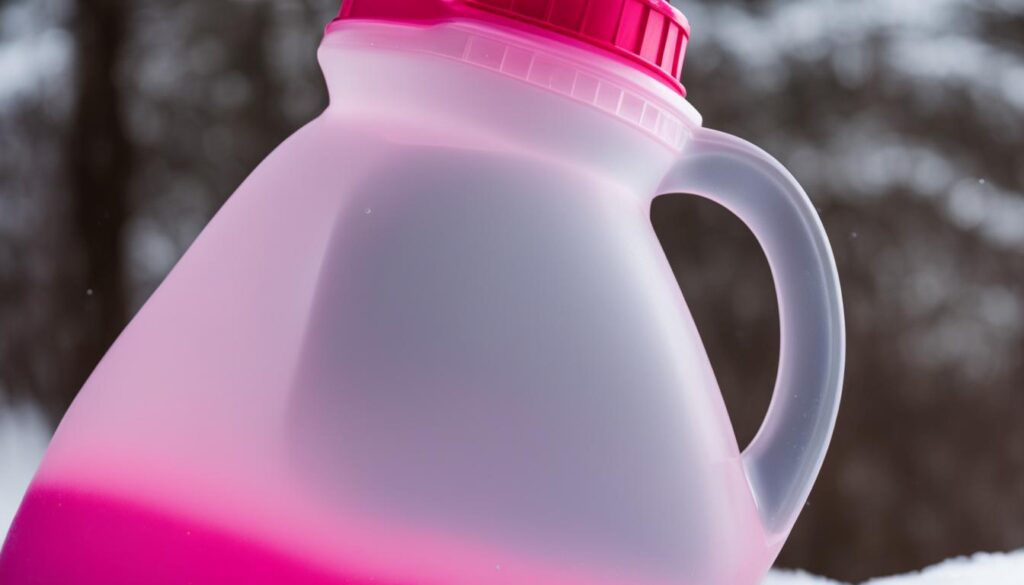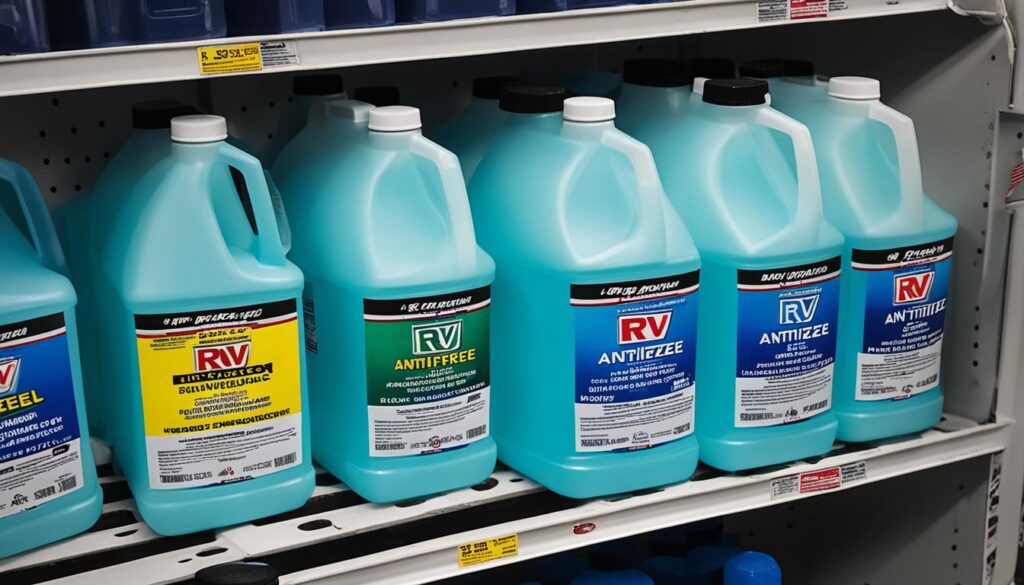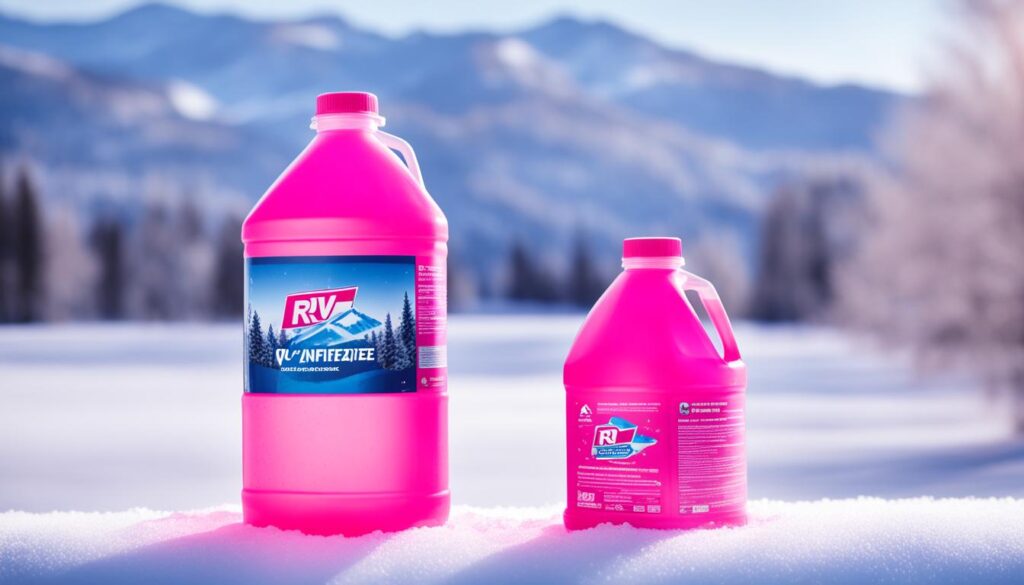As winter approaches, RV owners are faced with the important task of winterizing their vehicles to protect them from freezing temperatures. One crucial component of this process is the use of RV antifreeze to prevent the plumbing system from freezing and potentially causing costly damage. But just how much antifreeze does your RV need? Is there a specific calculation to determine the right amount?
In this comprehensive guide, we will explore the factors that determine the quantity of RV antifreeze needed for winterization. From the size and type of your RV to the recommended winterization steps, we will provide you with the information you need to ensure your RV is properly protected during the winter months.
So, if you’ve ever wondered how much RV antifreeze you should use or if you’re looking for a step-by-step guide to winterizing your RV, keep reading to find all the answers.
Key Takeaways:
- The amount of RV antifreeze needed for winterization depends on various factors, including the size and type of the RV.
- Following the recommended steps, which involve bypassing the water heater, generally requires 2-4 gallons of antifreeze.
- It is important to properly store any leftover antifreeze and have extra on hand for emergencies.
- Using RV-specific antifreeze is crucial to ensure the safety and effectiveness of the water system.
- Alternative winterization methods, such as using compressed air, can be used as an alternative to RV antifreeze.
Contents
What is RV Antifreeze?
RV antifreeze is a non-toxic formula specifically designed for use in RV plumbing systems. It is usually pink or red in color, making it easy to distinguish from other types of antifreeze. Unlike regular antifreeze, RV antifreeze is safe for consumption, although it should still be stored out of reach of children and pets. It is used to prevent the water in the RV plumbing system from freezing during cold weather.
One of the primary features of RV antifreeze is its non-toxic nature. This makes it an ideal choice for winterizing RVs because it eliminates the risk of ingesting harmful chemicals if accidentally consumed. The pink or red color of RV antifreeze also helps in preventing any confusion with other types of antifreeze, ensuring the right product is used for the RV plumbing system.
RV antifreeze plays a crucial role in protecting the water lines and faucets of an RV from freezing during cold temperatures. By circulating through the plumbing system, the antifreeze displaces any remaining water, providing a barrier against freezing temperatures. This prevents damage to the plumbing system that could result in costly repairs.
“RV antifreeze is a non-toxic and easy-to-use solution for ensuring the safety and functionality of your RV’s plumbing system during winterization.”
It is important to note that while RV antifreeze is non-toxic, it should still be stored properly. This means keeping it out of reach of children and pets, as well as ensuring the bottle is tightly sealed to prevent spills and contamination.
| Key Features of RV Antifreeze |
|---|
| Non-toxic formula |
| Pink or red color for easy identification |
| Safe for consumption but should be stored out of reach of children and pets |
| Protects RV plumbing system from freezing |
| Prevents costly damage to water lines and faucets |
RV antifreeze is a vital component of the winterization process for RVs. Its non-toxic nature, pink or red color, and effectiveness in preventing freezing make it an essential tool for protecting the plumbing system of your RV during colder months.
How to Use RV Antifreeze for Winterization
Using RV antifreeze is an essential step in winterizing your RV to protect its plumbing system from freezing temperatures. By following these simple steps, you can ensure the effective and thorough winterization of your RV.
- Bypass the water heater: Before you begin the winterization process, make sure to bypass the water heater. This will prevent unnecessary use of antifreeze and save you money.
- Drain the water system: Open all the faucets, valves, and low point drains to fully drain the water from the RV’s plumbing system. This will help remove any residual water that may freeze and cause damage.
- Connect to the antifreeze container: Connect the RV’s plumbing system to a container filled with RV antifreeze. This can be done using a special winterization kit or by connecting a hose directly to the container.
- Turn on the water pump: Turn on the RV’s water pump and open each faucet one at a time. Allow the antifreeze to flow through each faucet until it comes out consistently. This will ensure that every part of the plumbing system is protected.
- Protect the P-traps: Finally, pour antifreeze down each drain to protect the P-traps from freezing. This will prevent any damage to the traps and ensure a smooth start-up in the spring.
By following these steps, you can effectively winterize your RV using RV antifreeze and protect your plumbing system from the damaging effects of freezing temperatures.

Tips for Effective Winterization:
Consider using a non-toxic and biodegradable RV antifreeze to minimize any environmental impact.
Check your RV’s owner manual for any specific winterization instructions or recommendations.
Always wear protective gloves and eyewear when working with RV antifreeze to avoid any contact with your skin or eyes.
Determining the Amount of RV Antifreeze Needed
Calculating the appropriate amount of RV antifreeze is essential for effective winterization. Several factors come into play when determining the quantity required, including the size of the RV, the winterization method used, and the presence of additional appliances such as dishwashers and clothes washers. Follow the recommended steps and consider the following guidelines to ensure sufficient RV antifreeze:
- Consult the RV’s owner’s manual: Check the manufacturer’s recommendations to determine the recommended amount of antifreeze for your specific RV model.
- Seek advice from experienced RVers: Connect with experienced RV owners through online forums or local RV clubs to gather insights and recommendations based on their experiences.
- Consider the winterization steps: Following the standard winterization steps usually requires 2-4 gallons of antifreeze. Be sure to bypass the water heater and thoroughly flush all water lines and faucets with antifreeze to provide complete protection against freezing.
By taking these factors into account, you can determine the optimal amount of RV antifreeze needed to safeguard your plumbing system during the winter months.
Storage and Shelf Life of RV Antifreeze
RV antifreeze is an essential component for winterizing your RV and protecting its plumbing system from freezing temperatures. But what about storing RV antifreeze for future use? How long can you keep it, and does it have a shelf life? Let’s explore the topic of storing and preserving RV antifreeze to ensure its effectiveness when you need it most.
Proper Storage Techniques
When it comes to storing RV antifreeze, one of the most important things to remember is to tightly seal the bottle. This prevents any spills and ensures that no contaminants find their way inside, which could potentially compromise the antifreeze’s effectiveness. Additionally, make sure to store the antifreeze in a cool and dry place away from direct sunlight.
Shelf Life of RV Antifreeze
The shelf life of RV antifreeze can vary depending on various factors such as brand and composition. However, as a general guideline, it is recommended to use RV antifreeze within 1-4 years from the date of purchase. Most manufacturers label their products with an expiration date, which can be found on the bottle. While antifreeze may remain effective even after the expiration date, it is still advisable to replace it to ensure maximum effectiveness and peace of mind.
Using expired antifreeze could potentially lead to inadequate protection against freezing temperatures or other issues. Therefore, it is best to err on the side of caution and replace any expired RV antifreeze in your storage.
Periodic Replacement
In addition to proper storage techniques and monitoring the expiration date, it is a good practice to periodically replace RV antifreeze. Over time, antifreeze can lose its effectiveness, especially if exposed to extreme temperature fluctuations or contaminants. By periodically replacing your RV antifreeze, you can ensure that you always have a fresh and reliable supply on hand for when you need to winterize your RV.
In conclusion, properly storing and preserving RV antifreeze is crucial for maintaining its quality and effectiveness. Remember to tightly seal the bottle, store it in a cool and dry place, and adhere to the recommended shelf life guidelines. By following these practices, you can ensure that your RV antifreeze remains in optimal condition, ready to protect your RV’s plumbing system during those chilly winter months.

Winterizing without RV Antifreeze
While RV antifreeze is the go-to solution for winterizing an RV’s plumbing system, there are alternative methods available for those who prefer not to use antifreeze. One such method is winterizing with compressed air, which effectively blows out all the water from the plumbing lines, leaving the system dry and ready for the cold winter months.
To winterize your RV without antifreeze, you’ll need specific equipment, including an air compressor and suitable adapters. Here’s a step-by-step guide on how to winterize your RV using compressed air:
- Ensure the water heater is bypassed to prevent unnecessary use of antifreeze.
- Open all faucets and valves, including the low point drains, to allow water to drain from the system.
- Connect the RV’s plumbing system to the air compressor using the appropriate adapters.
- Gradually increase the air pressure to blow out the water from the system. Begin with a low pressure setting to avoid damaging the plumbing.
- Open each faucet one at a time and let the compressed air flow until no water comes out.
- Continue the process for all faucets, toilets, showers, and any other water outlets in the RV.
- Flush the toilet multiple times to ensure all water is removed from the bowl and tank.
- Finally, pour a small amount of plumbing antifreeze into each drain to protect the P-traps.
Following these steps will help ensure that your RV’s plumbing lines are completely water-free, reducing the risk of freezing and potential damage during the winter season.
It’s important to note that winterizing with compressed air requires careful attention to detail and adherence to the proper procedures. If not done correctly, residual water left in the system can still lead to freezing and cause damage. Therefore, it is recommended to consult your RV’s owner’s manual or seek advice from experienced RVers for guidance on using compressed air for winterization.
While winterizing without RV antifreeze can be an effective alternative, it may not be suitable for all situations. Factors such as the climate, duration of winter storage, and individual preferences should be taken into account when deciding on a winterization method.
Importance of Proper Winterization for RVs
Proper winterization of an RV is essential to safeguard the plumbing system from the risks of freezing and potential damage. Failure to winterize can lead to burst pipes, cracked fittings, and expensive repairs. RV antifreeze is a highly effective solution for preventing freezing, ensuring that the water in the plumbing system remains protected during cold weather.
However, there are alternative methods available, such as using compressed air, which can also be used to winterize an RV. Regardless of the chosen method, it is crucial to thoroughly flush the plumbing system with the selected winterization agent to ensure that all water is completely removed and replaced with antifreeze or expelled air. This process helps prevent any residual moisture from freezing and causing damage to the plumbing system.
Taking the necessary steps to winterize an RV is not only about protecting the plumbing system from freezing but also about preventing potential winter damage. By properly winterizing an RV, you can extend the life of the plumbing system and avoid costly repairs. It is a proactive measure that ensures your RV remains in optimal condition and ready for use when the winter season ends.
FAQ
How much RV antifreeze do I need to winterize my RV?
The amount of RV antifreeze needed varies based on the size of the RV and the winterization methods used. Following the recommended steps, which include bypassing the water heater, typically requires 2-4 gallons of antifreeze. It is also recommended to keep a jug of antifreeze on hand for emergencies and to store any leftover antifreeze properly.
What is RV antifreeze?
RV antifreeze is a non-toxic formula specifically designed for use in RV plumbing systems. It is usually pink or red in color, making it easy to distinguish from other types of antifreeze. Unlike regular antifreeze, RV antifreeze is safe for consumption, although it should still be stored out of reach of children and pets. It is used to prevent the water in the RV plumbing system from freezing during cold weather.
How do I use RV antifreeze for winterization?
To use RV antifreeze for winterization, the following steps are typically recommended: 1) Ensure the water heater is bypassed to avoid unnecessary use of antifreeze. 2) Drain the water system by opening all faucets and valves, including the low point drains. 3) Connect the RV’s plumbing system to a container filled with antifreeze. 4) Turn on the water pump and open each faucet one at a time until antifreeze flows. 5) Pour antifreeze down each drain to protect the P-traps. It is important to follow these steps carefully to ensure effective winterization of the RV plumbing system.
How do I determine the amount of RV antifreeze needed?
The amount of RV antifreeze needed depends on several factors, including the size of the RV, the winterization method used, and the presence of additional appliances such as dishwashers and clothes washers. Generally, following the recommended steps for winterization, which involve bypassing the water heater, requires 2-4 gallons of antifreeze. It is important to ensure all water lines and faucets are thoroughly flushed with antifreeze to protect against freezing. It may be helpful to consult the RV’s owner’s manual or seek advice from experienced RVers to determine the optimal amount of antifreeze needed for a specific RV.
How should I store and what is the shelf life of RV antifreeze?
RV antifreeze can be safely stored for future use. It is important to tightly seal the bottle to prevent spills and keep contaminants out. While the shelf life of RV antifreeze can vary, it is generally recommended to use it within 1-4 years of purchase. The expiration date can usually be found on the bottle. Even if the antifreeze remains effective after the printed expiration date, it is advisable to replace it to ensure maximum effectiveness. Proper storage and periodic replacement of RV antifreeze will help maintain its quality and effectiveness when needed.
Can I winterize my RV without using RV antifreeze?
Yes, it is possible to winterize an RV without using RV antifreeze by using compressed air to blow out all the water from the plumbing lines. This method is effective if done correctly and requires specific equipment, such as an air compressor and appropriate adapters. It involves opening all faucets and valves and using compressed air to force the water out of the system. While this method can be a viable alternative to using antifreeze, it is important to follow the proper procedures to ensure all water is removed from the plumbing system.
Why is proper winterization important for RVs?
Proper winterization of an RV is crucial to protect the plumbing system from freezing and potential damage. Failure to winterize can result in burst pipes, cracked fittings, and costly repairs. RV antifreeze is an effective solution for preventing freezing, but alternative methods such as compressed air can also be used. Regardless of the method chosen, it is important to thoroughly flush the plumbing system with the chosen winterization agent to ensure all water is removed and replaced with antifreeze or expelled air. Taking the necessary steps to winterize an RV will help extend the life of the plumbing system and prevent costly repairs.






